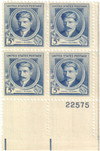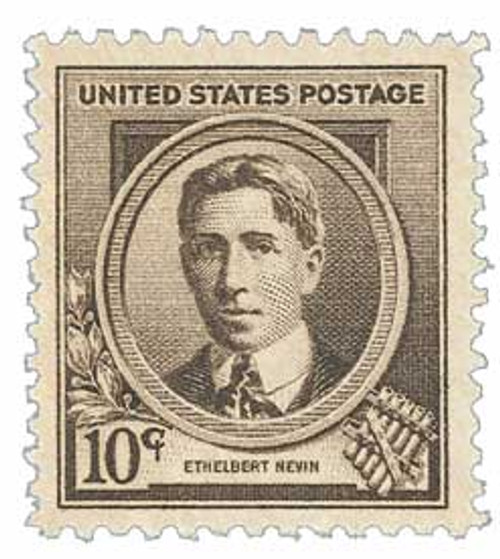
# 882 - 1940 Famous Americans: 5c Edward A. MacDowell
1940 5¢ Edward Alexander MacDowell
Famous Americans Series – Composers
First City: Peterborough, New Hampshire
Quantity Issued: 21,147,000
Printed by: Bureau of Engraving and Printing
Printing Method: Rotary Press
Perforation: 10 ½ x 11
Color: Ultramarine
Birth of Edward MacDowell
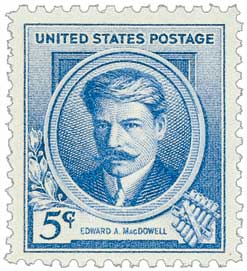
Composer Edward Alexander MacDowell was born on December 18, 1860, in New York City. He composed several notable works and was one of the first people inducted into the American Academy of Arts and Letters.
The son of a Manhattan milk dealer, MacDowell, received piano lessons from Juan Buitrago, Pablo Desverine, and Teresa Carreño. His mother then took him to France where he was admitted to the Paris Conservatory in 1877. MacDowell studied there for two years under Antoine François Marmontel before going to Frankfurt, Germany to study at Dr. Hoch’s Conservatory under Carl Heymann and Joachim Raff. By 1881, MacDowell began traveling and performing some of his own compositions.

MacDowell lived in Germany for a few years, composing, performing, and providing piano lessons. After getting married in 1884, MacDowell dedicated most of his time to composing. He and his wife moved to Boston in 1888, where he became a popular piano teacher and concert pianist, performing with the Boston Symphony Orchestra, among others.
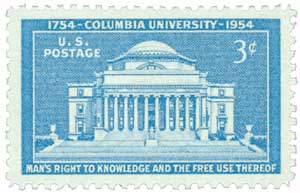
In 1896, MacDowell was made the first professor of music at Columbia University. He had been invited personally by the school’s president to establish a music department. That same year, MacDowell’s wife purchased a summer home in Peterborough, New Hampshire, where the natural beauty inspired his compositions. During his time there, he composed two piano concertos, two orchestral suites, four symphonic poems, four piano sonatas, and piano suites. MacDowell also published 13 piano pieces and four part songs under the name Edgar Thorn.
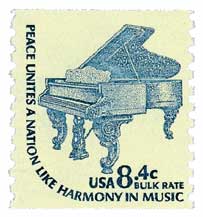
MacDowell received an honorary Doctor of Music degree from Princeton in 1896. He was elected president of the Society of American Musicians and Composers in 1899 and was one of the first seven people admitted to the American Academy of Arts and Letters.
By 1904, MacDowell’s job at Columbia had grown challenging. After clashing with the school’s new president, MacDowell resigned. MacDowell soon fell into a deep depression and his health began to suffer. He was also run over by a Hansom cab that year, which further contributed to his failing health. The Mendelssohn Glee Club, which MacDowell had once directed, raised money to help his family. Many of MacDowell’s friends also appealed to the public to donate, including Andrew Carnegie, J.P. Morgan, and former President Grover Cleveland.

In 1907, MacDowell’s wife helped him establish the MacDowell Colony as an artists’ residency and workshop at their Hillcrest Farm in Peterborough. The name was eventually shortened to MacDowell. MacDowell died at age 47 on January 23, 1908. After his death, MacDowell’s wife spent more than 25 years overseeing the MacDowell Colony. Over the years, the Edwin MacDowell Association has supported many rising composers including Samuel Barber and Leonard Bernstein. They received residencies, fellowships, and the Edward MacDowell Medal early in their careers, helping them get established. There have also been about 400 MacDowell music clubs around the country. These clubs have varied in size, with smaller ones having private meetings with talks and performances. Larger clubs held public events that included lectures, concerts, and art exhibitions. MacDowell was inducted into the national Classical Music Hall of Fame. It’s been said that his two concertos are the “most important works in the genre by an American composer other than Gershwin.”
1940 5¢ Edward Alexander MacDowell
Famous Americans Series – Composers
First City: Peterborough, New Hampshire
Quantity Issued: 21,147,000
Printed by: Bureau of Engraving and Printing
Printing Method: Rotary Press
Perforation: 10 ½ x 11
Color: Ultramarine
Birth of Edward MacDowell

Composer Edward Alexander MacDowell was born on December 18, 1860, in New York City. He composed several notable works and was one of the first people inducted into the American Academy of Arts and Letters.
The son of a Manhattan milk dealer, MacDowell, received piano lessons from Juan Buitrago, Pablo Desverine, and Teresa Carreño. His mother then took him to France where he was admitted to the Paris Conservatory in 1877. MacDowell studied there for two years under Antoine François Marmontel before going to Frankfurt, Germany to study at Dr. Hoch’s Conservatory under Carl Heymann and Joachim Raff. By 1881, MacDowell began traveling and performing some of his own compositions.

MacDowell lived in Germany for a few years, composing, performing, and providing piano lessons. After getting married in 1884, MacDowell dedicated most of his time to composing. He and his wife moved to Boston in 1888, where he became a popular piano teacher and concert pianist, performing with the Boston Symphony Orchestra, among others.

In 1896, MacDowell was made the first professor of music at Columbia University. He had been invited personally by the school’s president to establish a music department. That same year, MacDowell’s wife purchased a summer home in Peterborough, New Hampshire, where the natural beauty inspired his compositions. During his time there, he composed two piano concertos, two orchestral suites, four symphonic poems, four piano sonatas, and piano suites. MacDowell also published 13 piano pieces and four part songs under the name Edgar Thorn.

MacDowell received an honorary Doctor of Music degree from Princeton in 1896. He was elected president of the Society of American Musicians and Composers in 1899 and was one of the first seven people admitted to the American Academy of Arts and Letters.
By 1904, MacDowell’s job at Columbia had grown challenging. After clashing with the school’s new president, MacDowell resigned. MacDowell soon fell into a deep depression and his health began to suffer. He was also run over by a Hansom cab that year, which further contributed to his failing health. The Mendelssohn Glee Club, which MacDowell had once directed, raised money to help his family. Many of MacDowell’s friends also appealed to the public to donate, including Andrew Carnegie, J.P. Morgan, and former President Grover Cleveland.

In 1907, MacDowell’s wife helped him establish the MacDowell Colony as an artists’ residency and workshop at their Hillcrest Farm in Peterborough. The name was eventually shortened to MacDowell. MacDowell died at age 47 on January 23, 1908. After his death, MacDowell’s wife spent more than 25 years overseeing the MacDowell Colony. Over the years, the Edwin MacDowell Association has supported many rising composers including Samuel Barber and Leonard Bernstein. They received residencies, fellowships, and the Edward MacDowell Medal early in their careers, helping them get established. There have also been about 400 MacDowell music clubs around the country. These clubs have varied in size, with smaller ones having private meetings with talks and performances. Larger clubs held public events that included lectures, concerts, and art exhibitions. MacDowell was inducted into the national Classical Music Hall of Fame. It’s been said that his two concertos are the “most important works in the genre by an American composer other than Gershwin.”




